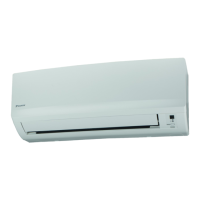
Do you have a question about the Daikin FTXN12NMVJU and is the answer not in the manual?
| Cooling Capacity | 3.5 kW |
|---|---|
| Heating Capacity | 4.0 kW |
| Seasonal Energy Efficiency Ratio (SEER) | 6.1 |
| Refrigerant | R-32 |
| Power Supply | 220-240V, 50Hz |
Explains hazard symbols and their associated risks.
Crucial safety warnings for installation and immediate handling.
Identifies and explains parts of the indoor unit.
Identifies and explains parts of the outdoor unit.
Identifies and explains functions of the remote control buttons.
Step-by-step guide for inserting batteries into the remote control.
Instructions for installing the remote controller holder on a wall.
Procedure to switch between Fahrenheit and Celsius temperature displays.
Notes on initial power-on sequence and battery life.
Automatically selects appropriate temperature and operation mode.
Lowers the temperature for cooling.
Lowers humidity while maintaining temperature.
Raises temperature for heating or circulates air.
Instructions on how to stop the air conditioner operation.
Procedure to adjust the desired temperature setting.
Recommendations for efficient energy usage and cost savings.
How to adjust the fan speed for comfort.
Information on the quiet operation mode and its settings.
How to activate and set the automatic flap swing.
How to manually adjust vertical louvers for desired airflow direction.
How to activate the comfort airflow feature for direct blowing prevention.
How to deactivate the comfort airflow feature.
How to maximize cooling/heating effect quickly.
How to stop the powerful operation mode.
How to enable efficient operation by limiting power consumption.
How to deactivate the econo operation mode.
Notes on using ECONO with other functions.
How to set the timer to turn the unit on.
How to cancel a set ON timer.
How to set the timer to turn the unit off.
How to cancel a set OFF timer.
How to set both ON and OFF timers simultaneously.
Information on the automatic temperature adjustment for sleeping hours.
Instructions for cleaning the indoor unit's front panel.
Steps to vacuum or wash the air filters.
How to clean the indoor unit, outdoor unit, and remote controller.
Guide for cleaning or replacing the titanium apatite photocatalytic air-purifying filter.
Instructions on opening the front panel of the indoor unit.
How to detach the air filters from the unit.
Detailed steps for cleaning the air filters.
Steps for reattaching filters and closing the front panel.
Instructions for cleaning the titanium apatite photocatalytic air-purifying filter.
Guidance on when and how to replace the titanium apatite filter.
Notes on the impact of dirty filters and ordering replacements.
Instructions for cleaning the front panel and air filters for specific models.
Guide for cleaning or replacing the titanium apatite photocatalytic air-purifying filter for specific models.
Steps to open the unit and remove air filters for specific models.
Detailed steps for cleaning and drying air filters.
Steps for reattaching filters and closing the front panel for specific models.
Instructions for cleaning and replacing the titanium apatite filter for specific models.
Notes on filter performance and part numbers for specific models.
Steps to take before storing the unit for a long period.
Advice on professional maintenance for optimal performance.
Explanation for flap movement delay.
Reason for airflow stopping during heat operation.
Explanation for sudden stops and sounds during heating.
Reasons for delayed operation start and mode changes.
Explanations for different operational sounds like flowing, blowing, ticking, whistling, clicking, clopping.
Reason for increased operating sound from the outdoor unit.
Explanation for water or steam emission from the outdoor unit.
Troubleshooting steps for no air coming out or air coming out with issues.
Checks for appropriate airflow settings and direction.
Verifying ECONO mode and air filter condition for airflow problems.
Checking for blockages and open windows/doors affecting airflow.
Explanation for mist formation during cooling.
Troubleshooting for units not receiving remote signals or limited range.
Troubleshooting for faint, non-working, or erratic LCD displays.
Explanation for odors and recommendation for cleaning.
Situations requiring immediate consultation with a dealer due to safety concerns.
Actions to take after a power failure or during lightning risk.
Guidelines for proper disposal of unit components and refrigerants.
Procedure to initiate fault diagnosis mode on the remote controller.
Table explaining system and unit error codes and their meanings.












